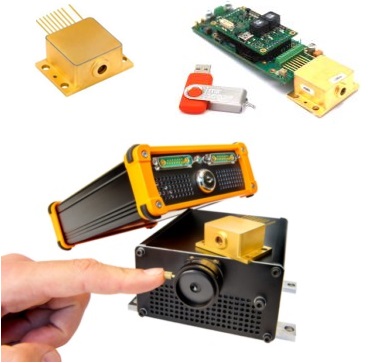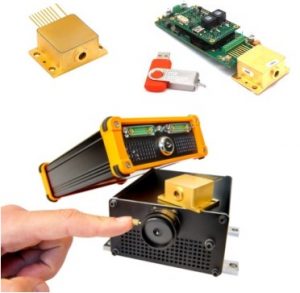PowerMir
Quantum Cascade Laser (QCL), Spectrally Multimode, QCW, 4-9µm, up to 1.5W
Key Features:
- Guaranteed minimum output power (up to ≈1.5W / lower power possible by request)
- Spectrally Multimode
- Chip, HHL, OEM & Turnkey
- CE mark/interlock for turnkey
- ITAR free technology
- QCW/high duty cycled pulsed
There are many different package types, wavelengths, output powers, and options to choose from. Get help selecting the right configuration for you!
POPULAR CONFIGURATIONS:
The PowerMir series is a line of high-power, pulsed Quantum Cascade Lasers based on proprietary technology, available in wavelengths from 4-9 µm and either turnkey benchtop systems, OEM driver laser module, HHL package, or chip. Our lasers operate in Quasi-Continuous Wave (QCW) mode, enhancing wall-plug efficiency and thermal dissipation. A minimum output power level is guaranteed for the various configurations (e.g., 0.1, 0.75, 1, or 1.5W). However, lower output powers are available upon request. The PowerMir series is ITAR-free, featuring high-powered diodes that emit in the primary atmospheric transmission bands. Our lasers produce a circular TEM00 Gaussian beam for superior performance.
The entire laser package is only 1.75 x 1.25 x 0.75 inches, weighing only 70 grams, making it ideal for integration into aerial combat vehicles where size and weight are of the utmost importance. In addition to the lasers, mirSense also offers a 24 VDC OEM laser driver for ease of integration. These drivers provide TEC control, frequency modulation, and external TTL triggering, in addition to basic ON/OFF functionality. Designed to be extremely lightweight and compact, they measure only 1.75 x 4.33 x 1.00 inches and weigh just 120 grams. The form factor, high average power, and wall-plug efficiency of these QCLs all combine to make the PowerMir series ideally suited for countermeasure and other defense applications. All QCL specifications are consistent and reproducible due to refined and streamlined manufacturing processes.
Overall, the PowerMir series provides customers with powerful, efficient, and customizable laser solutions that are reliable and easy to use, enabling them to achieve their desired performance levels with minimal hassle.
MWIR & LWIR QCLs Enable Efficient & Cost-Effective Material Characterization
White Paper: Quantum Cascade Lasers (QCLs) for Infrared Countermeasures
PowerMir HHL Package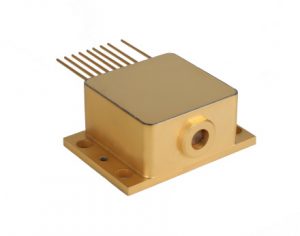
For clients who wish to purchase only the laser without the driving electronics, all of our laser wavelengths are available in a packaged version alone. Our standard offer is in an HHL package including the thermal regulation and a collimating lens. We are used to developing and supplying custom packages as well. For specific projects, mirSense can also supply QCL chips on submounts on demand.
PowerMir HHL Features:
- Standard high heat loads package (9-pins HHL) or custom package on request
- Integrated Peltier TEC cooler
- Integrated collimating lens (High beam quality, M²<1.5)
- Possibility of chips on submount delivery
- Optional circular beam with 2.5mrad divergence
PowerMir HHL Package with Driver (POEM system)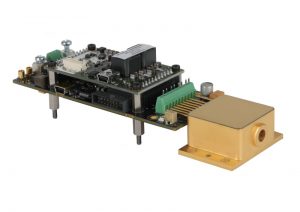
The PowerMir OEM system (POEM) is meant for customers who wish to integrate a QCL high-powered source inside their system (for example a DIRCM system). Each POEM is a compact light-weight and robust system made up of a packaged QCL laser plugged to a driving electronics board.
This board is embedded with unprecedented functionalities such as laser driver, complex programmable modulation schemes and of course full laser protection. The onboard firmware protects the laser from burning through temperature management of the TEC element. The customer can communicate with the board through MODBUS commands and a TTL trigger allows the customer to modulate each board with confidentiality. Several POEM systems can be combined to combine and increase the total optical output power.
PowerMir HHL Package with Driver Features:
- Compact stand-alone OEM product for system integration
- Powerful FPGA-based architecture
- MODBUS communication for system integration and user-friendly PC software for configuration and tests
- External TTL for synchronization
- Cost effective for series-productions
PowerMir Turnkey HHL Package with Driver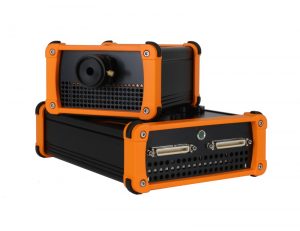
For lab experiments, we offer a plug-and-play easy to use turnkey system that includes laser heads, a driver and the cooling mechanism as well as a user-friendly PC software. In order to accommodate you in your future projects, the mirSense turnkey platform is very modular. It’s able to control simultaneously 2 different laser heads (with different or identical wavelengths).
PowerMir Turnkey Features:
- Plug-and-play system perfect to use inside a lab
- Stand alone system including: laser head, driver, heat exchanger
- User-friendly PC software allows users to:
- Turn ON/OFF the laser
- Easily change the operating mode (power, modulation)
- External TTL for synchronization
- Red laser beam to facilitate alignment
Benefits:
- High power and wall-plug efficiency:
- The PowerMir series delivers outstanding power and efficiency, allowing customers to achieve their desired performance levels while minimizing energy costs.
- Flexibility in configuration:
- Customers can choose from various system configurations, including plug-and-play benchtop turnkey systems, OEM driver laser modules, or just the HHL-packaged lasers. This flexibility allows customers to tailor their purchases to their specific needs and applications.
- Reproducible manufacturing:
- With reproducible specs manufacturing, customers can be confident that their orders will consistently meet their expectations and specifications.
- Circular beam option:
- The circular beam option reduces the amount of effort customers need to put into shaping the beam, saving them time and resources.
- ITAR-free technology:
- With ITAR-free technology, customers can rest assured that they are not violating any export control regulations.
- CE marked Interlock:
- the turnkey version has CE marking and built in interlock to meet safety specifications for your lab
- Highest quality beam:
- The TEM00 Gaussian beam allows for the highest quality beam, ensuring customers achieve the precision and accuracy required for their applications.
- User-friendly software:
- The included Windows software is easy to use, minimizing the learning curve for customers and allowing them to quickly integrate the PowerMir series into their workflows.
If you have any questions or need more information, please contact us.
| Wavelength (nm) | |
|---|---|
| Type |

 SHIPS TODAY
SHIPS TODAY 
